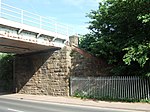Heathey Lane Halt railway station
Disused railway stations in the Borough of West LancashireFormer Lancashire and Yorkshire Railway stationsNorth West England railway station stubsPages with no open date in Infobox stationRailway stations in Great Britain closed in 1938 ... and 2 more
Railway stations in Great Britain opened in 1907Use British English from May 2013

Heathey Lane Halt was a railway station in the village of Scarisbrick, Lancashire. The station opened on 1 March 1907 as a halt on the Liverpool, Southport and Preston Junction Railway, and consisted of simple cinder based platforms at track level. It was situated to the north of the B5243 road bridge at Heathey Lane, to which it was connected by wooden steps. The station closed to passengers on 26 September 1938, though the line remained open for goods traffic until 21 January 1952. The track was left in place until 1964 for the storage of excursion stock.
Excerpt from the Wikipedia article Heathey Lane Halt railway station (License: CC BY-SA 3.0, Authors, Images).Heathey Lane Halt railway station
Birkdale Cop, West Lancashire Halsall
Geographical coordinates (GPS) Address External links Nearby Places Show on map
Geographical coordinates (GPS)
| Latitude | Longitude |
|---|---|
| N 53.6181 ° | E -2.972 ° |
Address
Heathey Lane
Birkdale Cop
PR8 5JD West Lancashire, Halsall
England, United Kingdom
Open on Google Maps










